N.Y.K. Line Hikawa Maru

Reviewed by Sean Hert

| HISTORY | |||||||||||||||||||||||||
|
Launched in 1929, the Japanese liner N.Y.K. (Nippon Yusen Kaisha) Hikawa Maru represented ocean travel at its most luxurious. The "Queen of the Pacific" was as famous for her exquisite art deco interiors and four-star cuisine as she was for carrying celebrity passengers like Charlie Chaplin. Prior to WWII, she carried Jewish refugees escaping Nazi Germany for Canada. During WWII, the Hikawa Maru served as a hospital ship, while her two sister ships were lost in action. After the end of the war she was used by the US for troop repatriation. By 1961, she had become a floating museum ship. She was fully restored to her former glory in 2007. (Source: Press Release, Wikipedia) Hasegawa's kit of Hikawa Maru is molded in white styrene, and is comprised of well over 300 parts. (The white styrene was difficult to photograph consistently well) |
|||||||||||||||||||||||||
| SPRUE A / HULL | |||||||||||||||||||||||||
|
This kit's full hull comes in two halves, split down the centerline and keel. As Hasegawa has done with previous 1/350 releases, there are bulkheads spaced throughout the interior to provide rigidity. The hull halves are mirror images of one another and have a great amount of detail. Raised lines to denote hull plating and the boot topping and bilge keels decorate the lower hull, while the upper parts of each hull section have molded in portholes and fairleads. The bulwarks and windows for the promenade deck are also molded into the hull, as are the stanchions for the poop deck on the stern. While these parts are perhaps a bit thick for representing the actual supports on the real ship, they should still look good when completed. There are two mounting holes in the bottom you will need to open up if you wish to use the included display stands. |
|||||||||||||||||||||||||
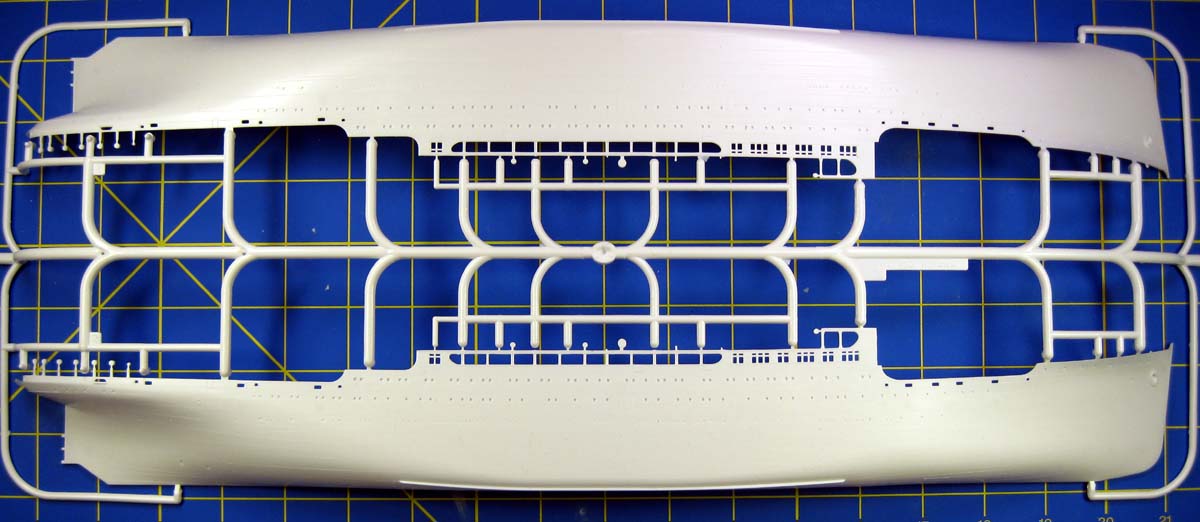 |
|||||||||||||||||||||||||
|
|||||||||||||||||||||||||
| SPRUES B | |||||||||||||||||||||||||
|
Sprue B has the main decks of the kit, including the forecastle and weather decks, as well as the promenade and boat decks amidships. The decks all feature regular wooden planking detail, molded on bitts, and well shaped cargo hatches. The cargo hatches are molded closed, with no option for positioning them open for loading/unloading operations dockside. |
|||||||||||||||||||||||||
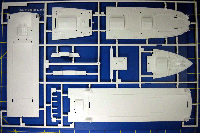 |
|||||||||||||||||||||||||
|
|||||||||||||||||||||||||
| SPRUE C | |||||||||||||||||||||||||
|
This sprue has the main superstructure deck, called the "boat deck" in the instructions. It also contains the poop deck part, the props and shafts, and the promenade deck bulkheads. The poop deck will require a number of holes to be drilled, both .8mm and 1.2mm diameter. The bulkheads have great detail; arched windows with frames, single and double doors and portholes. The boat deck has a load of great details as well; deadlights and hatches, etc. |
|||||||||||||||||||||||||
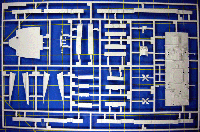 |
|
||||||||||||||||||||||||
| SPRUE D | |||||||||||||||||||||||||
|
Sprue D has the primary components for the bridge levels; the bulkheads and decks. The large one-piece rudder is on the sprue as well. The bulkheads are well detailed like the ones on sprue C. |
|||||||||||||||||||||||||
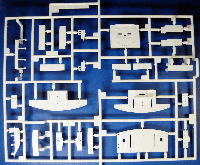 |
|||||||||||||||||||||||||
|
|||||||||||||||||||||||||
| SPRUE E | |||||||||||||||||||||||||
|
The small sprue has a large single part for the front of the bridge and superstructure. The windows on this part will be backed with clear parts from sprues U and V during assembly. It has the same great level of detail as seen on the previous parts. |
|||||||||||||||||||||||||
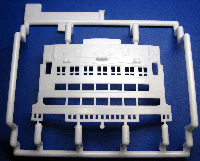 |
|||||||||||||||||||||||||
|
|||||||||||||||||||||||||
| SPRUES G x2 | |||||||||||||||||||||||||
|
Sprue G has the large variety of parts needed to bring a ship to life. Cargo booms, a set of ladders, and a large selection of fittings for placement on the decks. These deck fittings include cowl vents, vent stacks, bollards and chocks, and cargo winches. |
|||||||||||||||||||||||||
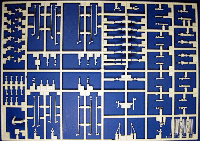
Sprue G |
|||||||||||||||||||||||||
|
|||||||||||||||||||||||||
| SPRUE Jx2, K | |||||||||||||||||||||||||
|
These sprues are joined together, with an additional J sprue provided. J has the boat and davit complement for Hikawa Maru; there are five styles of ship's boat carried. K has the parts to complete the open bridge forward on the boat deck. |
|||||||||||||||||||||||||
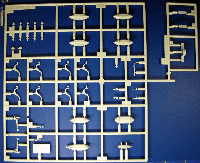 |
|
||||||||||||||||||||||||
| SPRUE N | |||||||||||||||||||||||||
|
Sprue N is the final primary sprue of parts, having the two masts, and the various kingposts. The large anchor winch and parts for the stack are present, as well as any remaining deck and detail parts like vent covers, boat winches and the like. |
|||||||||||||||||||||||||
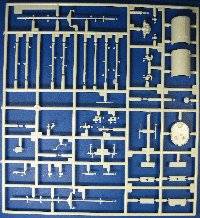 |
|
||||||||||||||||||||||||
| SPRUE R x2 | |||||||||||||||||||||||||
|
The two sprues here each make up one display stand, for a total of two display stands. |
|||||||||||||||||||||||||
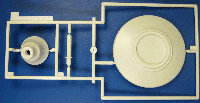 |
|||||||||||||||||||||||||
|
|||||||||||||||||||||||||
| SPRUE S | |||||||||||||||||||||||||
|
This sprue has the main interior bulkheads for the hull; a technique which Hasegawa introduced a few years ago, and now many plastic model manufacturers duplicate. |
|||||||||||||||||||||||||
 |
|||||||||||||||||||||||||
|
|||||||||||||||||||||||||
| SPRUE T | |||||||||||||||||||||||||
|
T has some remaining internal frames for the stern of the hull, and the internal spars to stiffen the superstructure. |
|||||||||||||||||||||||||
 |
|||||||||||||||||||||||||
|
|||||||||||||||||||||||||
| SPRUES U&V | |||||||||||||||||||||||||
|
These two sprues are molded on the same tree from clear styrene. U has a few searchlights, but is mainly made up of square flat sections to place behind gallery windows along the promenade deck, and some shorter ones for the chart house windows. V has some shaped sections for the bridge and forward superstructure windows. |
|||||||||||||||||||||||||
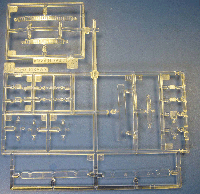 |
|
||||||||||||||||||||||||
| DECAL | |
|
The decal sheet includes signal flag decals and hull markings, to reflect time on the Seattle route, 1930-1941. |
|
 |
 |
| INSTRUCTIONS | |||||||||||||||||||||||||
|
A 24 page instruction book is included, There is also a full 1/350 scale poster with a painting guide, with a rigging diagram on the reverse. Also included is a guidebook with pictures (interior and exterior), the story of the ship in both Japanese and English, a replica postcard, and finally a guidebook- with coupon!- to visit the real ship and museum in Yokohama. The instructions are quite good, and laid out in a simple, logical style. When assembly order influences parts fit, there are directions indicating this. The color poster calls for a semi-gloss black for the hull, which looks grey in these scans. The orange-yellow for the masts, kingposts, vents, etc appears too bright and an alternate color choice may appeal to some. |
|||||||||||||||||||||||||
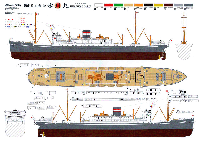 |
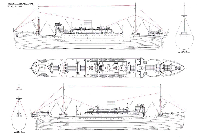 |
||||||||||||||||||||||||
|
|||||||||||||||||||||||||
| CONCLUSIONS | |||||||||||||||||||||||||

It is a nice change of pace to see some targets, ahem, non-warships appear on the market in a popular scale like 1/350. While the Hikawa is intended to represent her in the pre-war time period, those who may wish to convert into a wartime hospital ship have a great basic kit to start from- and the unused parts, coupled with the necessity of drill locator holes for some parts, certainly allude to other variants in the future. A good kit- a bit pricey- but recommended. Thanks to Great Planes Model Distributorsfor the review sample. It is listed as #40028 1/350 N.Y.K. Line Hikawa Maru with a MSRP of $159.95 US. Great Planes is the exclusive US importer for Hasegawa. |
|||||||||||||||||||||||||
